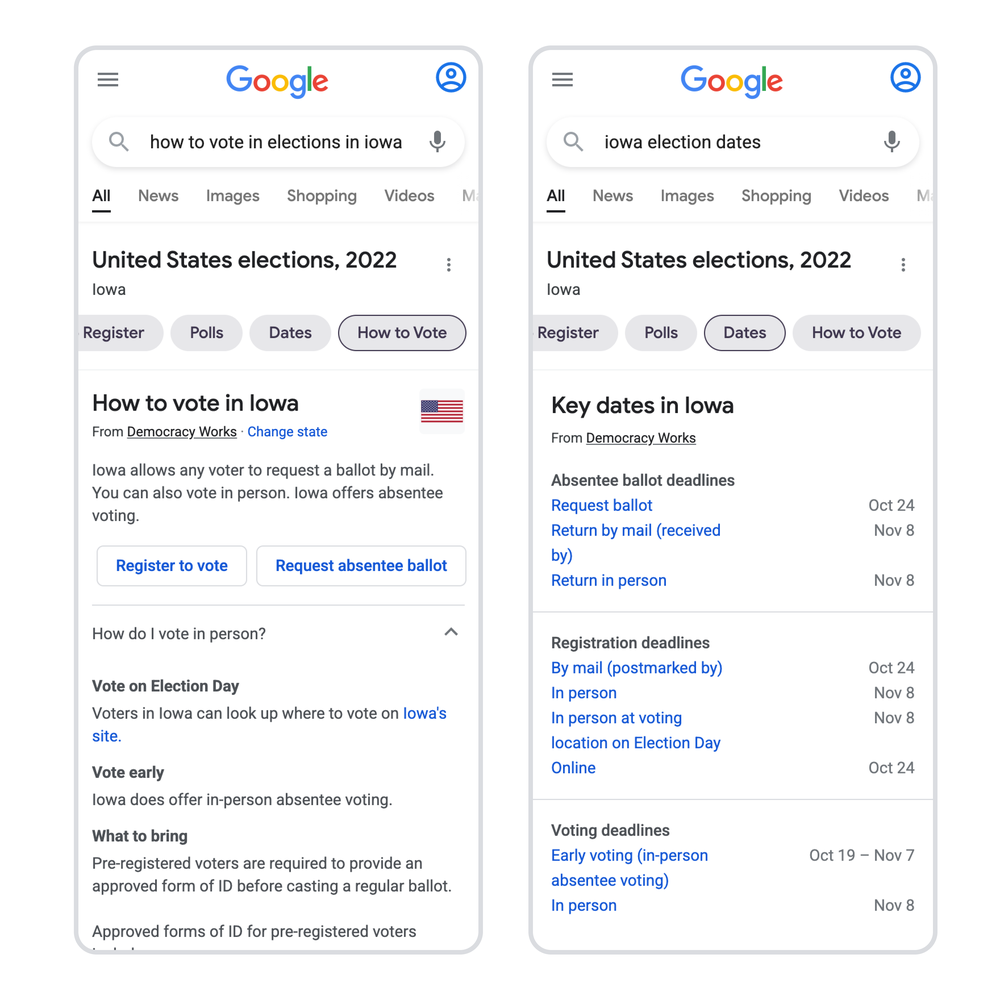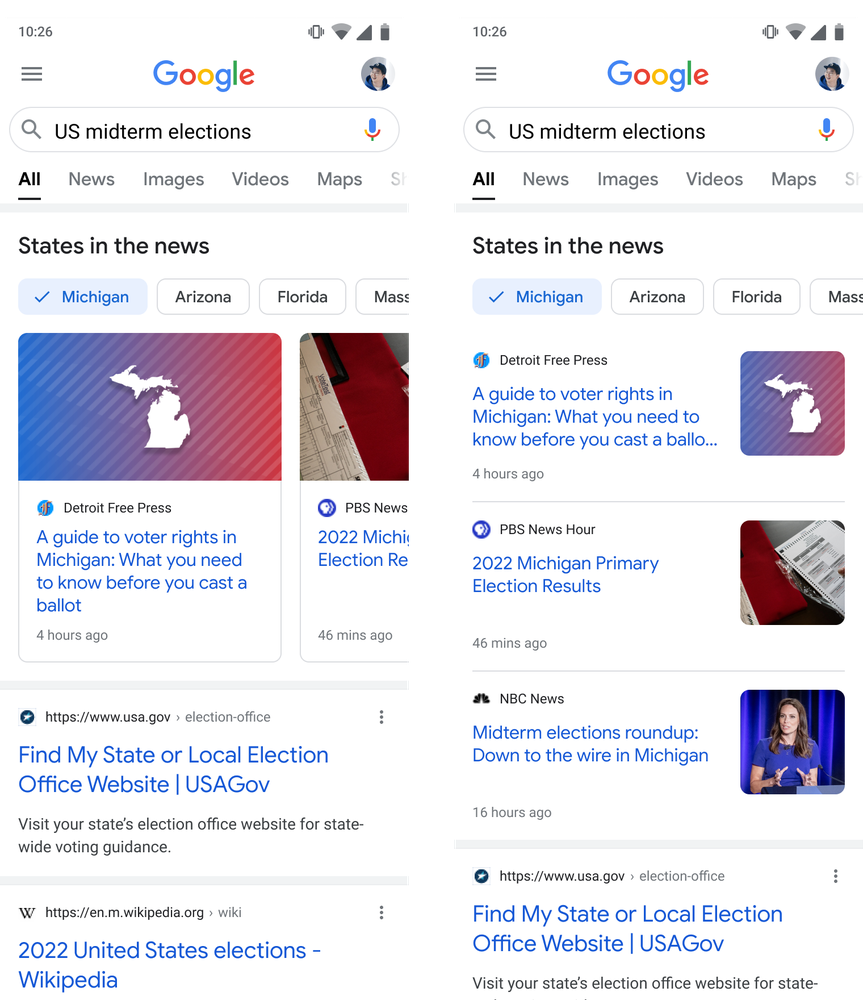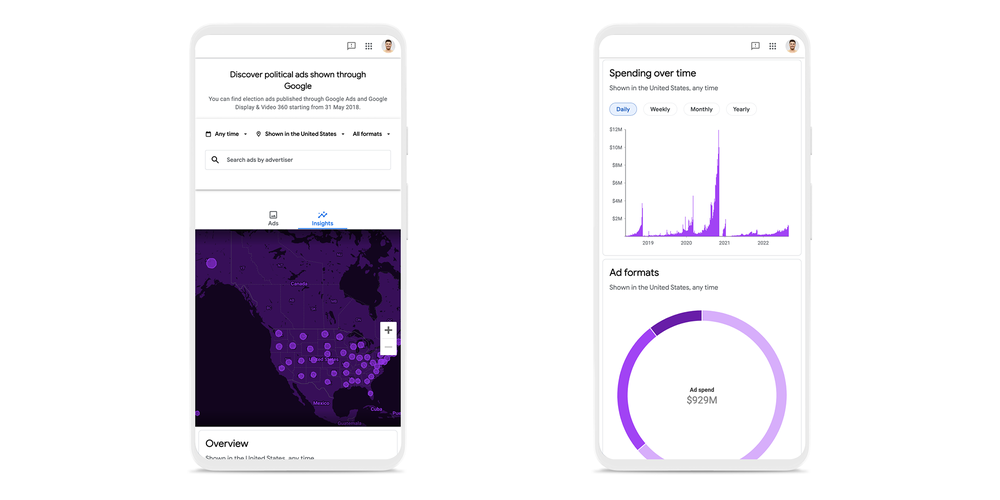In the last few months, voters have participated in elections around the world, including recently in France, Kenya, Colombia, Australia and primaries across the U.S. Our products and services have helped people find election information and protect the accounts of campaigns and election officials. We are continuing these efforts in Brazil, the U.S. general election and other elections globally.
Today, we’re sharing an update on our ongoing work related to the U.S. midterms. Our work is centered around connecting voters to the latest election information, helping campaigns and people working on elections improve their cybersecurity and protecting our users and platforms from abuse.
Making election information easily accessible
In the lead-up to elections, voters search for useful and relevant information to help them navigate the electoral process. That’s why we build features that show data from nonpartisan organizations to make it easier for people to get helpful election information.
As we’ve done for many previous elections, we’re rolling out features on Google Search to connect voters with accurate information about voter registration and how to vote. In the coming weeks, when people search for “how to vote” in both English and Spanish they’ll find election information panels sourced from Democracy Works, a nonpartisan and nonprofit data provider, which works directly with state election administrators to aggregate information about how they can vote in their state, along with key dates and deadlines, and guidance for options like voting early, in-person or by mail. The information panels will also link to state government official websites, which provide more information. And as with previous U.S. elections, we’re working with The Associated Press to present authoritative election results on Google.

We’re also making it easier to find authoritative news coverage on local elections from a range of sources. In addition to helping people find election news from their own communities, we’re launching a new feature that will help readers discover local and regional news from different states so they can better understand the election coverage of races they most care about. The feature will be launched in the coming weeks.

An example of how our new feature will show local and regional news from different states. Depending on the amount of coverage, readers may see a carousel or list of articles.
On YouTube, our systems are prominently recommending content from authoritative news sources, while limiting the spread of harmful election misinformation. We’ll also be showing relevant election information panels at the top of YouTube search results and underneath videos about the midterms to provide people with additional context about elections. Learn more about how YouTube is supporting the U.S. midterms here.
Supporting election security and training
Every election comes with increased cybersecurity risks. In fact, a recent survey shows that more than 41% of people working in politics and journalism had their digital accounts hacked or accessed without their permission in 2021. We understand this reality and are offering these high-risk users best-in-class security tools and resources.
To train and protect the security of people working on elections, we’ve been partnering with organizations like Defending Digital Campaigns, which has provided free security keys to over 300 national committees, state parties and political campaigns in all 50 states. To ensure the strongest account and site-level protections, we offer our free Advanced Protection Program and free Project Shield service to safeguard against digital attacks. Through our Campaign Security Project, we’ve teamed up with organizations across the political spectrum to train over 4,000 campaign and election officials on security best practices, including products and tools they can use to stay safe online.
Additionally, the Google News Initiative has continued to support a number of election-related trainings for journalists and newsrooms on identifying and combating misinformation. This year, in a partnership with the National Association of Black Journalists, we are helping to train over 700 journalists from publications across the country by the end of 2022. And we’re working with Poynter to provide additional tools and resources for hundreds of Spanish-speaking reporters and other news outlets as they prepare to cover the midterms.
Protecting our users and platforms
Preventing abuse on our platforms — such as account hijackings, phishing attempts or orchestrated disinformation campaigns — is always a top priority, especially during sensitive times like elections. Our Trust and Safety teams and Threat Analysis Group are working around the clock to monitor and stop these kinds of digital threats, and we’ve continued to make significant investments in our global operations to ensure our products remain safe and secure.
We also have longstanding policies that prohibit election-related abuse on our platforms. This continues to include policies to combat the spread of election misinformation and demonstrably false claims that could significantly undermine participation or trust in the electoral process, such as false information about polling locations, means of voting, candidate eligibility or election results. As always, we will continue to apply these policies in a neutral and apolitical way.
When it comes to election advertising, we want to make sure voters have confidence in the ads content they may see on our platforms. That’s why we require all advertisers to complete averification process and enforce strict ads policies, such as limiting the way advertisers can target election ads. We’ve also made significant investments in enhancing transparency around election advertising. In fact, earlier this year we updated our Political Ads Transparency Report, creating a new user interface and adding new tools for accessing and filtering information about targeting, location and formats for specific election ads and advertisers. The new report also includes a more granular breakdown of advertiser data — giving users and researchers greater insight into ad spending and impressions based on the latest Congressional redistricting information. And globally, we’re expanding our election ads verification policies and transparency tools to more countries, including Argentina and Brazil.

We’re committed to helping people navigate the electoral process around the world, and we will continue to share updates about our ongoing work.
